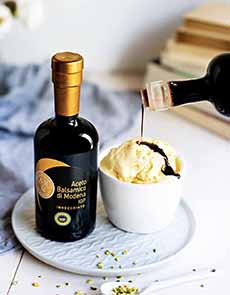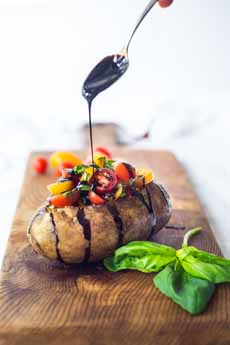TIP OF THE DAY: Know Your Balsamic Vinegar (It’s Balsamic Vinegar Of Modena Day)
|
|
The Consorzio Aceto Balsamico di Modena (Consortium of Balsamic Vinegar of Modena) has declared a new food holiday: November 1st Balsamic Vinegar of Modena Day. Balsamic vinegar is one the most important Italian food products—and also one of the most knocked-off. There is a lot of balsamic vinegar sold that is imitation balsamic. It hasn’t been made according to the rules and regulations of the Consorzio Some inexpensive supermarket or big chain balsamics are simply cheap red wine vinegar colored and flavored with caramel. If it’s inexpensive, it’s imitation! With so many bottles on the shelves, it’s not always easy to locate the authentic Balsamic Vinegar of Modena. be To certain: > Here’s more about imitation balsamic. > The different types of balsamic vinegar. > The different types of vinegar: a photo glossary. Below: > The history of balsamic vinegar. > Favorite ways to use balsamic vinegar. > The year’s 6 vinegar holidays. Today, the authentic balsamic vinegar of Modena, Italy—Aceto Balsamico di Modena—is still made under the same very strict conditions that have guided it for centuries. Balsamic Vinegar of Modena specifications require that: But that’s not all! In order for the product to be certified as Balsamic Vinegar of Modena, analytic and organoleptic tests by expert technicians and tasters are performed on the vinegar while it’s still in barrels. If it passes the test finished product is then packaged into glass, wooden, ceramic or terracotta containers of varying sizes. The European logo of the “Protected Geographical Indication” guarantees the authenticity of the product to the consumers. The oldest and most complex balsamics are the “traditional” balsamics, Aceto Balsamico Tradizionale di Modena. These are aged for a minimum of 12 years. Extra Vecchio (Extra Old) balsamics are aged for a minimum of 25 years. The older they get, the more the vinegar evaporates in the barrel, the more concentrated and syrupy the vinegars becomes. You can find balsamics aged 50, 75 years, and older, costing hundreds of dollars for just 3.4 ounces. These precious balsamics are not used in cooking, but as garnishes: dribbled by the drop onto Parmigiano-Reggiano or other fine cheese, foie gras, seafood, ice cream…or as a digestif at the end of the meal, served on a little spoon. Whether invecchiato or younger, any balsamic can be used in:
|
|
|
THE HISTORY OF BALSAMIC VINEGAR Balsamic Vinegar of Modena’s origin dates back to ancient Rome, when grape must* was cooked down into a syrup used as a sweetener and condiment—and as a medicine, too. Production of balsamic vinegar became linked with the Italian city of Modena during the 11th century. Toward the end of the 13th century, the art of vinegar production was cultivated at the court of the Dukes of Este in Modena. But it was not until 1747 that the adjective “balsamic” appeared in the registers of the cellars of the dukes. In the 19th century, Balsamic Vinegar of Modena became known and appreciated abroad. Since then, the bitter-sweet balanced flavor, with its intense deep brown color and luscious aroma, has become a favorite with connoisseurs worldwide. Here’s more of the history of balsamic vinegar. Here’s more about how balsamic vinegar is made. ________________ *Grape must (from the Latin vinum mustum, young wine ) is freshly crushed grape juice that contains the skins, seeds, and stems of the fruit. †There are two National Vinegar Days. June 16th is been mentioned in some older newspaper archives, but November 1st is the date more commonly associated with the holiday. CHECK OUT WHAT’S HAPPENING ON OUR HOME PAGE, THENIBBLE.COM. |
||









